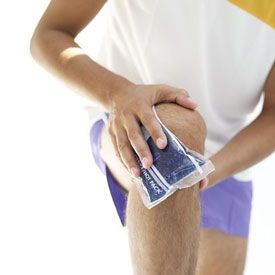 Knee pain is a common complaint that affects people of all ages. A few reasons one may be experiencing knee pain include: a sudden increase in one’s training or activity schedule, the commencement of a new sport or activity, a change in footwear, improper training technique, or muscle imbalances and/or alignment issues.
Knee pain is a common complaint that affects people of all ages. A few reasons one may be experiencing knee pain include: a sudden increase in one’s training or activity schedule, the commencement of a new sport or activity, a change in footwear, improper training technique, or muscle imbalances and/or alignment issues.
Understanding what is causing your knee pain is the first step in treating it, and there are many possible causes of mechanical knee pain which include:
patello-femoral syndrome, patellar fracture, bursitis, Ilio-tibial band friction syndrome, patellar or quadriceps tendinopathy, ligament injuries/sprains, Meniscal injuries/tears, Osteoarthritis, Osgood-Schlatter’s disease, Loose Bodies, etc…
Knee pain is one of the most common cycling injuries. The most common cause of knee pain in cyclists in ilio-tibial band (IT band) syndrome. The IT band is a thick band of fibrous tissue that runs down the outside of the upper leg from the hip area to the knee. Pain usually results when the IT band becomes too tight and therefore rubs over the bony prominences of the knee. The IT band has direct attachments to the tensor fascia latae (TFL) muscle, which runs down along the outer front of the thigh/hip area and acts to help flex and abduct the hip. This muscle, which is used consistently in cycling, often becomes shortened and/or tight, thereby increasing tension on the IT band and contributing to knee and/or hip pain.
As injury can often be a problem of overuse, or misuse, it is important to avoid the temptation to do too much (especially if just starting out with a new sport/activity, or commencing a training season). To avoid misuse of muscles, and prevent injury, it is important to ensure appropriate training technique and equipment fit (ie: bike fit). With cycling, it is important to add in a stretching program for your lower extremities to help maintain a healthy and appropriate muscle length while training.
In order to determine the cause of one’s knee pain, a comprehensive examination of the knee is completed and the appropriate treatment plan is outlined.
Treatment for knee pain can include:
1) Electrotherapy such as ultrasound to decrease swelling, pain, speed up cell turn over and thus enhance healing and recovery.
2) Interferential current may be used to decrease swelling or joint effusion, decrease pain, and speed up recovery.
3) Heat may be used to decrease pain and increase range of motion
4) Ice may be used to decrease inflammation and pain
5) Soft tissue work to improve circulation, break up adhesions, decrease muscle tightness or tension, decrease pain
6) Joint mobilizations to increase range of motion, decrease stiffness, increase circulation, and decrease pain
7) Passive stretching to increase muscle length
8) Taping to improve muscle function or joint alignment and decrease pain
9) Comprehensive exercise program to correct for muscle imbalances, increase flexibility, improve strength / stability / proprioception.
Below are a few exercises to help prevent knee injuries:
- Glute med strengthening – use theraband or stretchy tubing tied around ankles. In standing with legs straight and core contracted, side step (with straight legs) to left against the resistance of the band around the ankles. Continue for a minimum of 15 steps or until fatigue and then return to the starting point by side stepping to the right as above.
- Double leg or single leg squat, either on a BOSU or on the ground with a stability ball against the wall (your back leaning against the stability ball).
- Hamstring, Hip flexor stretching, and IT band rolling on foam roller
Remember to follow the PRICE principle if you believe you’ve sustained an acute knee injury, until you’ve been assessed from your health care practitioner.
P – Protect: Avoid anything that could cause further harm/injury or increase pain
R – Rest: Discontinue any and all physical activity as much as possible
I – Ice: Apply ice, 15-20 min max, 3-4 times/day
C – Compression: Wrap the injured area with a tensor bandage etc applying pressure around the area (to help decrease swelling and inflammation)
E – Elevation: Sit or lie with the limb or injured area elevated
Written by Jessica McCartie M.P.T.

 The recent winner of a prestigious environmental prize, Mike Biddle and MBA Polymers are changing what we think of as recyclables.
The recent winner of a prestigious environmental prize, Mike Biddle and MBA Polymers are changing what we think of as recyclables. In her book, The Women’s Migraine Survival Guide, Christina Peterson, M.D., offers some advice on an array of migraine triggers that women (and men too!) with chronic migraines should learn about and avoid. Here are the most common:
In her book, The Women’s Migraine Survival Guide, Christina Peterson, M.D., offers some advice on an array of migraine triggers that women (and men too!) with chronic migraines should learn about and avoid. Here are the most common: I’ve only been running for 21 months (that’s 1 3/4 years). Over the last year I ran 2 half marathons, a few 10k races and a handful of other, shorter races. It seems like the time has come for me to challenge myself to a full marathon. That’s right, 26 miles. 42.2 km in Canadian. Until now, sheer persistence and willpower have edged me past the 10k mark and into the 21.1 km races. No real training, just running a bit further each time. But I know that to be able to run 42.2 km sustainably, I will need real training. So on the spur of the moment I joined a 16-week running clinic. We meet to run twice a week – Wednesday after work and Saturday at 8:00 am – and there are 2 easy, short ‘homework’ runs. We will do hills, stairs, speedwork, and just plain distance running. See, that last one is the one I like best. No problem getting out there and just running. It’s the hard work that I balk at, so that’s why I’m training with a group led by experienced long distance runners.
I’ve only been running for 21 months (that’s 1 3/4 years). Over the last year I ran 2 half marathons, a few 10k races and a handful of other, shorter races. It seems like the time has come for me to challenge myself to a full marathon. That’s right, 26 miles. 42.2 km in Canadian. Until now, sheer persistence and willpower have edged me past the 10k mark and into the 21.1 km races. No real training, just running a bit further each time. But I know that to be able to run 42.2 km sustainably, I will need real training. So on the spur of the moment I joined a 16-week running clinic. We meet to run twice a week – Wednesday after work and Saturday at 8:00 am – and there are 2 easy, short ‘homework’ runs. We will do hills, stairs, speedwork, and just plain distance running. See, that last one is the one I like best. No problem getting out there and just running. It’s the hard work that I balk at, so that’s why I’m training with a group led by experienced long distance runners.